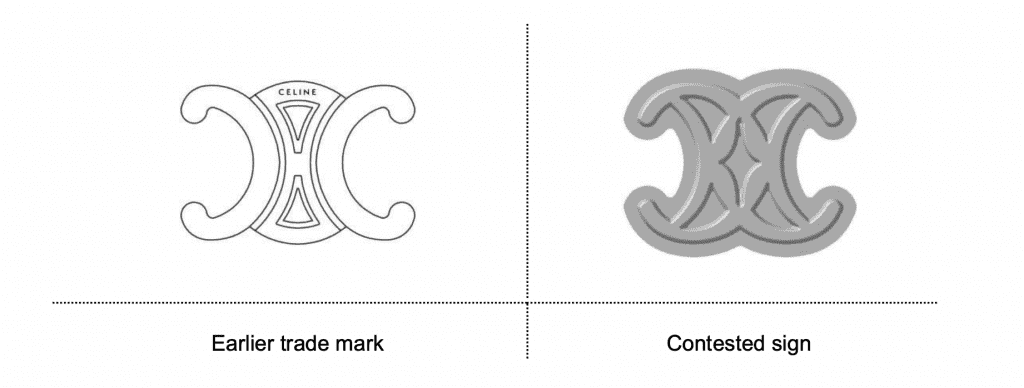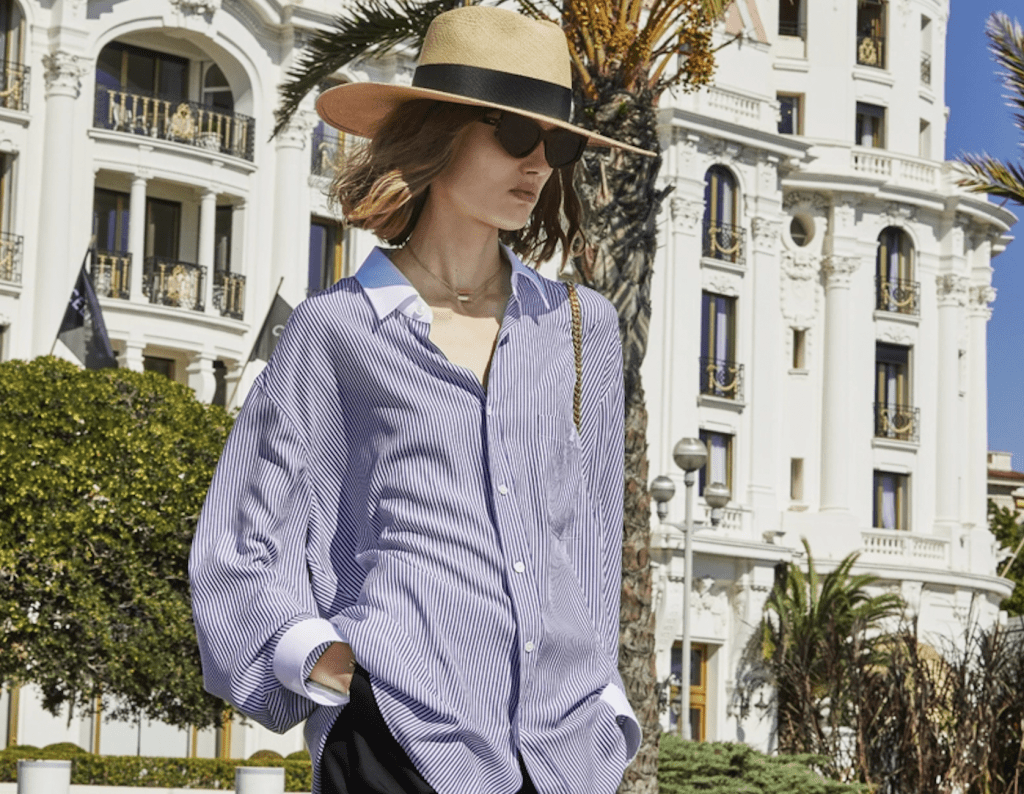Celine has prevailed in a quest to block the registration of a lookalike logo for use on clothing, footwear, and handbags in the European Union. In a decision dated March 15, a panel for the Opposition Division of the European Union Intellectual Property Office (“EUIPO”) sided with Celine, determining that consumers are likely to be confused between the offerings of the LVMH-owned brand and German entity CO.R.D. GmbH & Co. Kg should the latter make use of the trademark at issue, which consists of a symbol that mimics Celine’s interlocking “C” Triomphe logo for use on the same types of goods as the famed fashion brand.
In refusing to register the trademark at the heart of CO.R.D. GmbH & Co. Kg (“CO.R.D.”)’s application, which Celine sought to block by way of an opposition that it filed back in January 2021, the EUIPO’s Opposition Division panel focused its attention on the threshold question of whether a likelihood of confusion exists between the two parties’ marks. Assessing the individual likelihood of confusion factors, including “the similarity of the signs, the similarity of the goods and services, the distinctiveness of the earlier mark, the distinctive and dominant elements of the conflicting signs, and the relevant public,” the Opposition Division asserts in a newly-issued decision that there is, in fact, a risk that “the public might believe that [any of CO.R.D.’s] goods or services … that bear the marks in question” come from or are otherwise affiliated with Celine.
Primarily, the Opposition Division found that at least some of the goods that CO.R.D. identified in its application – namely, Bags in Class 18 and “Clothing; footwear; headgear; belts” in Class 25 – are identical to the types of goods that Celine maintains trademark rights in. At the same time, it determined that the marks, themselves, share “substantial similarities,” with both marks, for instance, having a “general structure consisting of two letters ‘C’ (or, for part of the public, two arch-shaped figurative elements) that are displayed in opposite position and with their respective open portion placed outwards.”

While there are differences between the two marks, such as the “secondary verbal element ‘CELINE’” that is part of the Celine mark, and differing “decorative details, such as lines and contour,” the Opposition Division ultimately held that the “overall stylization and structure” of the marks is “visually similar to an average degree overall.” As such, both of these factors weighed in favor of a likelihood of confusion.
The Opposition Division paid a fair amount of attention to the distinctiveness of the Celine logo and how the individual marks would be perceived by consumers (namely, “the public at large” with an “average” degree of attention) in the decision. Among other things, the trademark body asserted that while French consumers might perceive the inclusion of the CELINE wordmark within the brand’s mark as “as a reference to ‘Céline’, a feminine name of French-origin,” that is likely not how it would be viewed by non-French-speaking consumers. “Another part of the public, such as a substantial part of the Italian-speaking consumers, will perceive [that] component as a coined word,” according to the Opposition Division. “Indeed, the name ‘Céline’ is rather rare in Italy, [and] furthermore, its Italian correspondent is somehow different, being ‘Celina.’”
Against that background, the Opposition Division found it appropriate to “focus the comparison on this substantial part of the Italian-speaking part of the public, for which the element ‘CELINE’ is meaningless and therefore, distinctive to an average degree.”
Placing more weight on the shape of the Hedi Slimane-designed brand’s logo as a whole than on the inclusion of the “Celine” name (or lack thereof), the trademark body noted that “when signs consist of both verbal and figurative components – as it is [the case for Celine’s] mark – the verbal element of a sign does not automatically have a stronger impact.” Here, the Opposition Division determined that for the Celine trademark, the “figurative element is clearly dominant (visually outstanding) over the verbal component ‘CELINE’, which occupies an extremely limited proportion of the earlier mark.”
Doubling down on its finding that the shape of the logo is the most “distinctive and dominant component,” the Opposition Division stated that generally in connection with the sale of apparel and accessories, “the choice of [an] item of clothing and bags is generally made visually.” As such, “the visual perception of the marks in question will generally take place prior to purchase,” making it so that “the considerable visual similarities between the signs are particularly relevant … when assessing the likelihood of confusion.”
As for the distinctiveness of the Celine logo, the Opposition Division asserted that it “retains an average degree of inherent distinctiveness being a highly stylized and complex device that is not directly related to the relevant goods in a way that could impair its distinctiveness.” In this vein, the Opposition Division found that evidence submitted by CO.R.D. “does not demonstrate that consumers have been exposed to widespread use of, and have become accustomed to, trademarks that include stylized ‘C’ shapes.” (This is, of course, an interesting finding given that one of the most famous – and readily identifiable – trademarks in the fashion/luxury space is the interlocking “C” logo that Chanel has been using consistently since the 1920s.)
“Since the opposition is successful on the basis of the inherent distinctiveness of the earlier mark,” the Opposition Division declared that “there is no need to assess the enhanced degree of distinctiveness of the opposing mark due to its reputation as claimed by the opponent. The result would be the same even if the earlier mark enjoyed an enhanced degree of distinctiveness.”
With the foregoing in mind, the Opposition Division found that “there is a likelihood of confusion on the part of the Italian-speaking part of the public,” which is significant, as “a likelihood of confusion for only part of the relevant public of the European Union is sufficient to reject the contested application.” In siding with Celine, trademark body refused to register CO.R.D.’s mark and ordered the company to pay for the “fees and costs” incurred by Celine in connection with the proceedings.
Jérôme Tassi, a partner specializing in intellectual property at Paris-based firm AGIL’IT, states that the matter is particularly interesting in light of the fact that Celine’s mark “contains the word CELINE in small print, [but] has had no corresponding element in mark at the center of the contested application.” Reflecting on the Opposition Division’s decision, Tassi says that “in a complex mark, the verbal element [i.e., the CELINE word mark] is not necessarily [the dominant element] even if it is often deemed to be the case” in other trademark matters. In this matter, Tassi notes that the Opposition Division clearly viewed “the figurative element is to be dominant given its size” and given that “in the field of fashion, the visual element often plays an essential role in the assessment of the risk of confusion.”
No small win, goods bearing Celine’s Triomphe logo, namely, a number of handbags, have been helping to drive sales at Celine, with LVMH specifically pointing to the “strong demand” for Hedi Slimane’s Triomphe leather goods line (and ready-to-wear) as responsible for growth in the first nine months of 2021. The group also cited the “record year” that Celine had in 2021 in its annual report, noting that the brand’s leather goods business “benefitted from growth in the Triompe and 16 lines,” in particular.
The matter is Celine v. CO.R.D. GmbH & Co. Kg, Nо. B 3 138 445.











